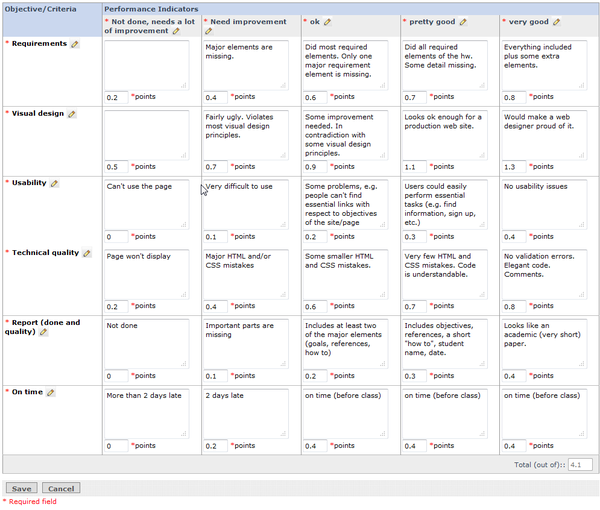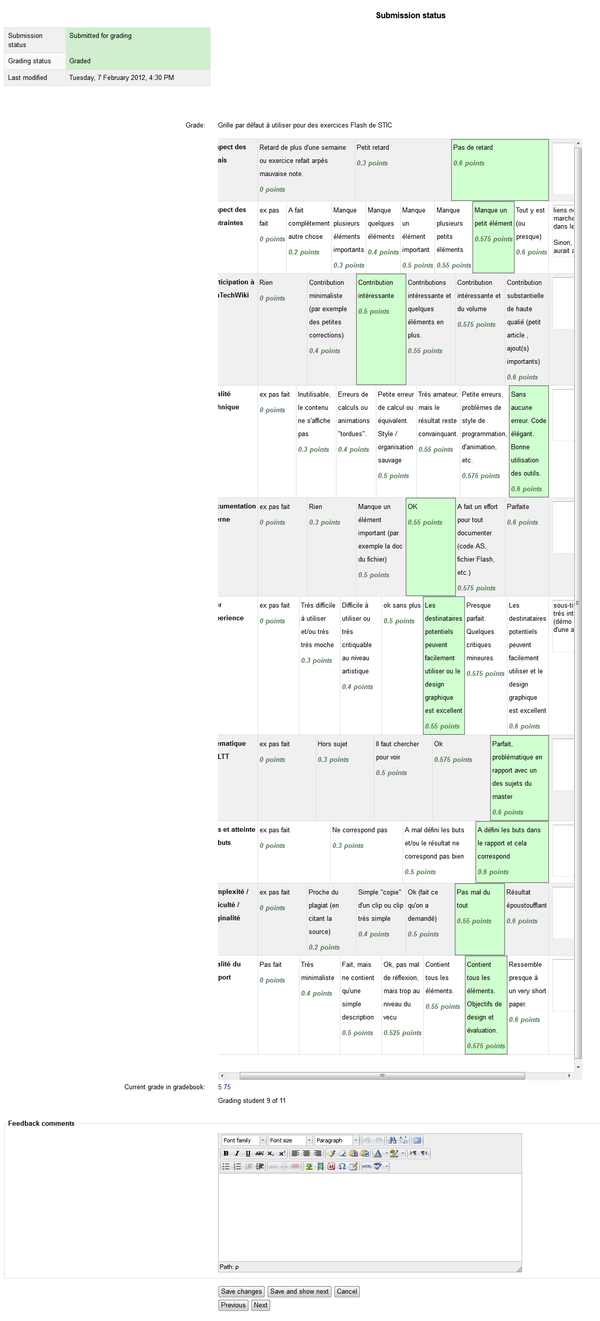Grading form
Introduction
A grading form usually refers to a rubric you can use to grade students' work based on specific criteria. Such forms can be paper-based or electronic. The latter can be found in so-called teacher productivity tools, learning management systems, etc. or can exist as stand alone tool.
See also:
So far, this piece is written as a practical introduction and does not refer to research ....
A typical scheme for a "rectangular" rubric could look like this:
| Performance measure | Performance measure | |
|---|---|---|
| Criterion 1 | Performance indicator | Performance indicator |
| Criterion 2 | Performance indicator | Performance indicator |
| Criterion 2 | Performance indicator | Performance indicator |
Definitions
“Scoring rubrics are descriptive scoring schemes that are developed by teachers or other evaluators to guide the analysis of the products or processes of students' efforts (Brookhart, 1999). Scoring rubrics are typically employed when a judgement of quality is required and may be used to evaluate a broad range of subjects and activities.” (Moskal, 2000, retrieved 18:59, 17 October 2012 (CEST))
“A rubric is simply a scoring tool that identifies the various criteria relevant to an assignment or learning outcome, and then explicitly states the possible levels of achievement along a continuum (poor to excellent or novice to expert). Rubrics can be used to assess almost any type of student work be it essays, final projects, oral presentations, or theatrical performances. They can be used at the time that an assignment is made to communicate expectations to students, when student work is evaluated for fair and efficient grading, and to assess a program by determining the extent to which students are achieving departmental learning outcomes.” (DePaul University, , retrieved 18:59, 17 October 2012 (CEST)).
Purpose
Grading rubrics can have several purposes:
- Help the teacher think about expected learning outcomes
- Communicate expectations to students
- Help students plan, e.g. if the evaluation includes strategic elements, like "clarity of objectives"
- Help students to self-assess a work before they turn it in
- Clear summative assessment of performance (grading)
- Formative assessment of performance (the teacher can annotate rubric fields)
- Reduction of grading time
- Getting more out of students by evaluating intermediary products in project-oriented learning with a rubric
Types of student work that can be assessed with a rubric
Rubrics are clearly useful for the assessment of unstructured and/or complex productions such as:
- Essays
- Research papers
- field notes
- literature reviews or summaries
- Term projects
They are also useful for assessing "conversational artifacts", such as:
- forum discussions
- presentations
- portfolios
- note taking
- ....
Development and use of a grading rubric
Rubrics can (but must not) be developed together with students. For example, students can be asked how they would define a good work. Then one could ask how they would define an outstanding one and one that only meets basic requirements. One also could take prior student work and ask students how they differ from each other.
In any case, developing a good rubric should be related to both overall learning goals (what a teacher desires to achieve in class or in a program) and "local" objectives (what students should learn doing the work to be evaluated).
A good rubric may rely on the following principles:
- Criteria are complete with respect to what is expected
- Criteria are understandable
- Each slot should include explicit and observable indicators
- Sequence of criteria should be principled, e.g. match the order in which a teacher looks at criteria or group similar items next to each other.
- Indicators should be reliable (e.g. a second teacher should select the same slots)
- Should be tested with real students (in practice, this means that you should revise the rubric before you use it again)
However, since creating a perfect rubric takes a lot of time, we also argue that using a half-baked rubric where detailed indicators are missing from some slots is better than using none ....
When handing out assignments, the rubric should be presented to all students. At least, you should make sure that they understand that they can consult it before getting started.
Software
Rubrics support in LMSs
Blackboard learn, version ?
Blackboard supports a similar system. I.e. a teacher has to define
- Objectives/criteria
- Performance indicators which are the same for all criteria, i.e. one cannot use different performance indicators for different criteria
- Points must be assigned to each slot
- Each slot then should be documented, ideally with one or more operational indicator(s)
Below is a simple rubric for homework grading we made for an 8-week CSS class. A total of 6 homework was handed one and this covers some of these. As you can see, some of the indicators are not really operational, but such a grid is better than the usual letter grade associated with a few comments.
The first screenshot shows the authoring interface allowing to define criteria and performance indicators.

As you can see, in the grading interface, the teacher cannot annotate slots but just add comments at the end.

Rubrics cannot be saved and copied to other classes, which is a major issue. I.e. I feel angry at having to fill in the same kind of rubric again and again ...
Moodle 2.0
Moodle 2.0 supports Rubrics. These are available under advanced grading forms.
Moodle's solution is different from Blackboards.
The rubric consists of a set of criteria. For each criterion, several descriptive levels are provided. A numerical grade is assigned to each of these levels. The rater chooses which level answers/describes the given criterion best. The raw rubric score is calculated as a sum of all criteria grades. The final grade is calculated by comparing the actual score with the worst/best possible score that could be received.
Below is a screen shot (in french) that again shows a homework rubric. Each homework is a mini-project that is graded according to 10 critera. Moodle allows to use different performance indicators for each criterion which makes more sense, but may be more difficult to handle for some teachers.
Authoring interface:

Unfortunately, default Moodle themes represent an anthology in bad CSS design and waste of screen estate. Both for authoring an grading, a teacher will have to scroll sideways and stare at 50% of empty white. We can't help that since we have better to do than creating usable themes for an LMS we only use for grading purposes .... I am just very much impressed how little LMS designers understand about web design. I probably couldn't do that much better but then I don't aim to be a web designer - Daniel K. Schneider 22:21, 18 October 2012 (CEST)
Grading interface. Each criterion can be annotated.

Online tools
- iRubric is an online rubric, that is part of a larger toolset. Quote: “RCampus is a comprehensive Education Management System and a collaborative learning environment. At RCampus, you can do all your school-related work from building personal and group websites to managing your courses, eportfolios, academic communities, and much more.”, retrieved oct. 20 2012.
- Quote: “is a comprehensive rubric development, assessment, and sharing tool. Designed from the ground up, iRubric supports a variety of applications in an easy-to-use package. iRubric is free to individual faculty and students.”
- This web site also includes nice examples, you could use with another tool.
Standalone tools
- Rubystar is a free tool to help teachers create quality rubrics.
- Other
- Roobrix Quote: is a tool that helps educators avoid grading errors when scoring rubrics.
- General Rubric Generator Simple rubric generator.
Links
Introductions to rubrics
(also may include examples)
- What is a Rubric ? DePaul University, retrieved 18:59, 17 October 2012 (CEST)
- Creating Rubrics. This five-part series explores how one teacher designs, refines, and implements rubrics in a variety of subject areas, retrieved 18:59, 17 October 2012 (CEST).
Resource sites
- Assessment and Rubrics This part of Kathy Schrock's Guide to Everything! is very complete.
Grading rubric examples
- Utah Education Network Grading rubrics tool. Login is required for creation of rubrics, but rubrics can be consulted. Retrieved oct. 2012
- http://www.carla.umn.edu/assessment/vac/Evaluation/p_7.html
To sort out
- Evidence-Based Assessment (but we would not qualify the "no child left behind" initiative as truly evidence-based).
- Assessment (Edutopia)
Bibliography
- Brookhart, S. M. (1999). The Art and Science of Classroom Assessment: The Missing Part of Pedagogy. ASHE-ERIC Higher Education Report (Vol. 27, No.1). Washington, DC: The George Washington University, Graduate School of Education and Human Development.
- Dornisch, Michele M. and Sabatini McLoughlin, Andrea. (2006). Limitations of web-based rubric resources: Addressing the challenges. Practical Assessment, Research & Evaluation, 11(3). Retrieved November 3, 2009.
- ERIC/AE, Scoring Rubrics - Definitions & Construction, http://ericae.net/faqs/rubrics/scoring_rubrics.htm, retrieved 18:59, 17 October 2012 (CEST).
- Fraile, J., Panadero, E., & Pardo, R. (2017). Co-creating rubrics: The effects on self-regulated learning, self-efficacy and performance of establishing assessment criteria with students. Studies in Educational Evaluation, 53, 69–76.
- Huba, M. E. & Freed, J. E. (2000). Learner-centered assessment on college campuses: Shifting the focus from teaching to learning. Boston, MA: Allyn & Bacon.
- Johnson, B. (1996). The Performance Assessment Handbook: Designs from the Field and Guidelines for the Territory Ahead. Princeton, NJ: Eye on Education.
- Knecht, R., Moskal, B. & Pavelich, M. (2000). The Design Report Rubric: Measuring and Tracking Growth through Success, Paper to be presented at the annual meeting of the American Society for Engineering Education.
- Moskal, Barbara M. & Jon A. Leydens (2000). Scoring rubric development: validity and reliability. Practical Assessment, Research & Evaluation, 7(10).
- Lazear, D. (1998). The Rubrics Way: Using MI to Assess Understanding. Tucscon, AZ: Zephyr Press.
- Moskal, Barbara M. (2000). Scoring rubrics: what, when and how?. Practical Assessment, Research & Evaluation, 7(3), HTML
- Popham, W. James. (1997). What's Wrong--and What's Right--with Rubrics. Educational Leadership,55(2). Retrieved November 3, 2009.
- Stevens, D. D. & Levi, A.J. (2005) Introduction to rubrics: An assessment tool to save grading time, convey effective feedback and promote student learning. Sterling, VA: Stylus.
- Taggart, G.L., Phifer, S.J., Nixon, J., & Wood, M. (Eds.). (1998). Rubrics: A Handbook for Construction and Use. Lancaster, PA: Technomic Publishing.